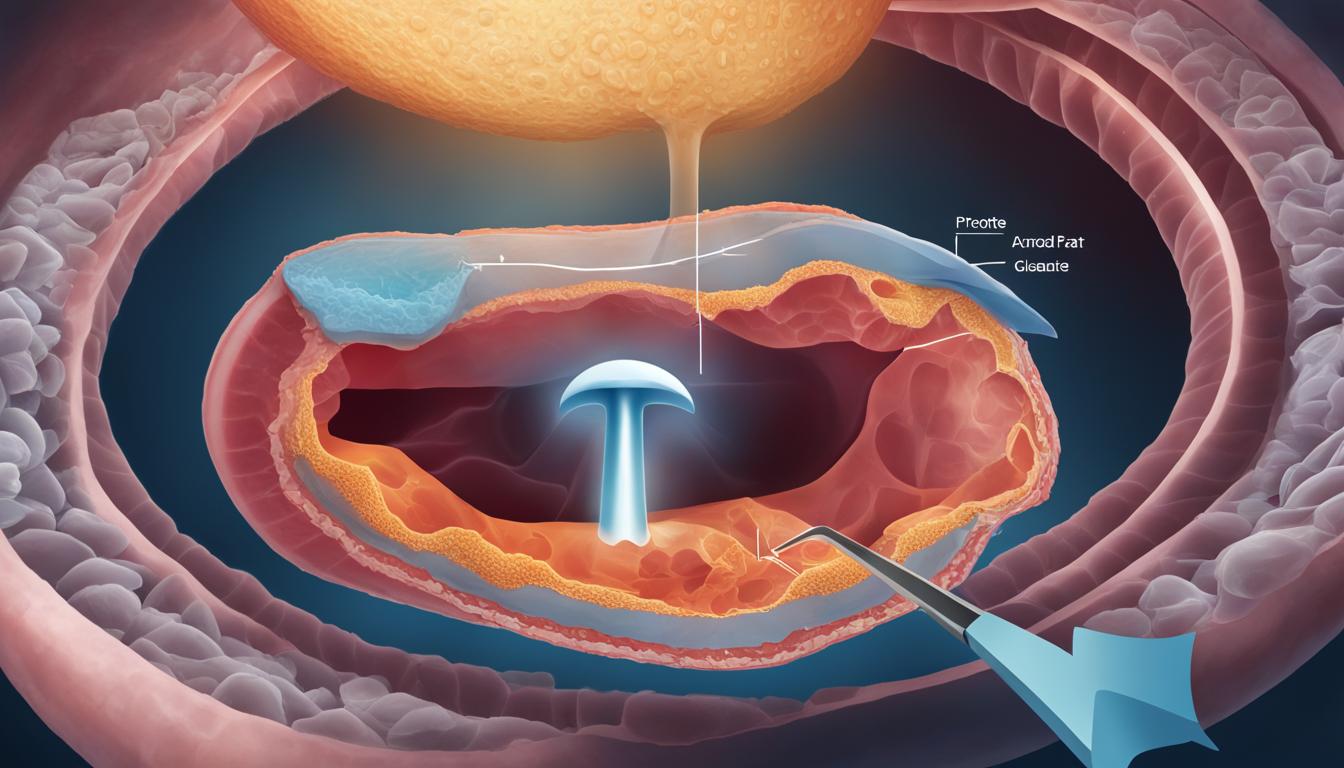Welcome to our article on the main cause of prostate enlargement, also known as benign prostatic hyperplasia (BPH). In this section, we will explore the primary reasons behind prostate enlargement and the factors that contribute to this common condition.
One of the main causes of prostate enlargement is hormonal changes that occur with age. As men get older, the balance of hormones in their body, particularly testosterone and estrogen, is disrupted. This hormonal imbalance leads to the growth of the prostate gland, resulting in the symptoms associated with BPH.
It is important to note that prostate enlargement is not directly linked to an increased risk of prostate cancer. While both conditions can occur simultaneously, BPH does not necessarily indicate the presence of cancer.
Key Takeaways:
- Hormonal changes with age are the primary cause of prostate enlargement.
- Prostate enlargement, or BPH, is not directly linked to an increased risk of prostate cancer.
Symptoms of Prostate Enlargement to Watch Out For
If you suspect prostate enlargement, it’s important to be aware of the common signs and symptoms. Prostate enlargement, also known as benign prostatic hyperplasia (BPH), can cause various urinary problems that can negatively impact your quality of life. By recognizing the symptoms early on, you can take proactive steps to manage the condition and seek appropriate medical attention.
Common Signs of Enlarged Prostate:
- A frequent need to urinate
- Difficulty starting and stopping urination
- Weak urine flow
- Dribbling at the end of urination
- The feeling of not fully emptying the bladder
In addition to these common symptoms, there are other less common signs that may indicate prostate enlargement:
- Urinary tract infections
- Blood in the urine
- The inability to urinate
It’s important to note that these symptoms can vary from person to person, and the severity can range from mild to more pronounced. If you experience any of these symptoms or notice changes in your urinary habits, it is advisable to consult with a healthcare professional for an accurate diagnosis and appropriate management.
“Recognizing the symptoms of prostate enlargement is crucial in getting the necessary medical attention and finding the right treatment options for your condition.”
To help you understand the symptoms better, here’s a visually engaging table summarizing the common signs of prostate enlargement:
| Symptoms | Description |
|---|---|
| A frequent need to urinate | An increased urge to urinate more often than usual. |
| Difficulty starting and stopping urination | Struggling to initiate urination or experiencing a delay in stopping the flow. |
| Weak urine flow | A reduced force or velocity of urine during urination. |
| Dribbling at the end of urination | Leaking or dribbling urine even after you’ve finished urinating. |
| The feeling of not fully emptying the bladder | A sensation that the bladder is not completely emptied after urination. |
Remember, the presence of these symptoms doesn’t automatically indicate prostate enlargement, as they can also be signs of other urinary tract issues. Only a healthcare professional can provide an accurate diagnosis through a thorough evaluation of your medical history, physical examination, and appropriate tests.
When to Seek Medical Attention
If you experience any of the symptoms mentioned or have concerns about your urinary health, it’s essential to seek medical attention. Early detection and appropriate management can help prevent complications and ensure a better quality of life. Don’t hesitate to reach out to a healthcare professional who can guide you through the diagnostic process and recommend suitable treatment options.
Risk Factors for Prostate Enlargement
Prostate enlargement, also known as benign prostatic hyperplasia (BPH), is a common condition that affects many men, particularly as they age. While the exact cause of BPH is not fully understood, several risk factors have been identified that contribute to the development of prostate enlargement.
Age
Age is the most significant risk factor for prostate enlargement. As men get older, the likelihood of developing BPH increases. It is estimated that more than half of all men in their 60s and up to 90% of men in their 70s and 80s will experience symptoms of prostate enlargement.
Family History
A family history of prostate problems, such as an enlarged prostate or prostate cancer, can increase an individual’s risk of developing BPH. If a man has a father or brother who has had prostate issues, he is more likely to develop an enlarged prostate himself.
Obesity
Obesity has been identified as a risk factor for prostate enlargement. Studies have shown that excess body weight, particularly abdominal fat, is associated with an increased likelihood of developing BPH. Maintaining a healthy weight through regular exercise and a balanced diet may help reduce the risk of prostate enlargement.
Diabetes
Diabetes, especially poorly controlled diabetes, has been linked to an increased risk of developing prostate enlargement. The exact relationship between diabetes and BPH is not fully understood, but it is believed that high blood sugar levels and insulin resistance may play a role in the development of prostate enlargement.
Heart Disease
Heart disease, including conditions such as high blood pressure and coronary artery disease, has been associated with an increased risk of prostate enlargement. The exact mechanisms underlying this relationship are not yet clear, but it is believed that shared risk factors, such as obesity and inflammation, may contribute to both conditions.
To summarize, several risk factors contribute to the development of prostate enlargement, including age, family history, obesity, diabetes, and heart disease. Understanding these risk factors can help individuals make informed decisions about their health and take appropriate steps to reduce their risk of developing an enlarged prostate.

Complications of Prostate Enlargement
Prostate enlargement, also known as benign prostatic hyperplasia (BPH), can have various complications that can significantly impact a man’s quality of life. These complications arise due to the compression of the urethra and the resulting urinary flow obstruction caused by the enlarged prostate gland.
Effects on Urinary System:
- Urinary Retention: The narrowing of the urethra can lead to the incomplete emptying of the bladder, causing urine to accumulate. This condition, known as urinary retention, can result in discomfort, frequent urination, and increased risk of urinary tract infections.
- Urinary Tract Infections: A stagnant urine flow and incomplete bladder emptying can create an ideal environment for bacteria to multiply, leading to urinary tract infections. Symptoms may include pain or burning during urination, cloudy or bloody urine, and a frequent urge to urinate.
- Bladder Stones: When urine is retained in the bladder for prolonged periods, minerals in the urine can crystallize and form stones. These bladder stones can cause pain, frequent urination, and hematuria (blood in the urine).
- Bladder Damage: In some cases, the continuously increased pressure on the bladder caused by an enlarged prostate can lead to bladder wall damage. This damage may result in reduced bladder capacity and urinary incontinence.
- Kidney Damage: Severe or untreated cases of prostate enlargement can lead to kidney damage. The obstruction caused by the enlarged prostate may hinder the normal flow of urine from the kidneys, leading to kidney infections, kidney stones, or even kidney failure.
It is crucial for individuals with an enlarged prostate to be aware of and address these potential risks and complications promptly. Seeking medical attention and appropriate treatment can help alleviate symptoms, restore normal urinary function, and prevent further health issues.

Diagnosing Prostate Enlargement
Diagnosing prostate enlargement, also known as benign prostatic hyperplasia (BPH), involves a comprehensive evaluation that includes a physical exam and medical tests. These assessments help healthcare professionals rule out other conditions and determine the severity of the prostate enlargement.
The first step in diagnosing prostate enlargement is a digital rectal exam (DRE). During this exam, a healthcare provider inserts a gloved finger into the rectum to feel the size and shape of the prostate gland. This examination helps identify any abnormalities or irregularities.
Additional medical tests are performed to gather more information and confirm the diagnosis of prostate enlargement. These tests may include:
- Urine test: A urine sample is analyzed for signs of infection or blood in the urine, which may be caused by an enlarged prostate.
- Blood tests: Blood tests, such as a prostate-specific antigen (PSA) test, may be conducted to measure the levels of specific substances related to prostate health. Abnormal results can indicate prostate enlargement or other prostate conditions.
Once the diagnosis of prostate enlargement is confirmed, further assessments may be done to determine the best treatment approach. These may include imaging tests, such as an ultrasound or a cystoscopy, to evaluate the size and condition of the prostate gland and assess any potential complications.
It’s important to consult a healthcare professional for an accurate diagnosis and personalized treatment plan. Proper diagnosis is essential to ensure appropriate management and to prevent complications associated with prostate enlargement.
Treatment Options for Prostate Enlargement
When it comes to the treatment of prostate enlargement, also known as benign prostatic hyperplasia (BPH), there are several options available. The choice of treatment depends on the severity of symptoms and individual patient factors, and it is important to consult with a healthcare professional for personalized recommendations.
Lifestyle Changes:
In mild cases of prostate enlargement, lifestyle modifications can be effective in managing symptoms and improving overall prostate health. These modifications may include:
- Reducing alcohol and caffeine intake
- Exercising regularly
- Practicing bladder training techniques
- Maintaining a healthy weight
- Avoiding constipation
Medications:
In cases where lifestyle changes alone are not sufficient, medications may be prescribed to help reduce the size of the prostate and relax the bladder. These medications can help alleviate urinary symptoms and improve quality of life. Some commonly prescribed medications for BPH include:
- Alpha-blockers: These medications relax the muscles in the prostate and bladder neck, making it easier to urinate.
- 5-alpha reductase inhibitors: These medications help shrink the prostate by reducing the production of dihydrotestosterone (DHT), a hormone that contributes to prostate growth.
- Combination therapy: In some cases, a combination of alpha-blockers and 5-alpha reductase inhibitors may be prescribed for maximum symptom relief.
Surgical Procedures:
For more severe cases of prostate enlargement or when medication and lifestyle changes are not effective, surgical intervention may be necessary. Surgical procedures aim to remove or reduce the size of the prostate, relieving urinary symptoms. Some common surgical procedures for BPH include:
- Transurethral resection of the prostate (TURP): This minimally invasive procedure involves the removal of excess prostate tissue through the urethra.
- Laser surgery: Various types of laser surgery can be used to vaporize or remove prostate tissue.
- UroLift System: This procedure involves the placement of small implants to hold the prostate lobes apart and open up the urethra, improving urine flow.
It is important to note that the choice of treatment should be made in consultation with a healthcare professional, taking into account the individual’s overall health and preferences. Regular follow-up appointments are also necessary to monitor the effectiveness of the chosen treatment and make any necessary adjustments.
| Treatment Options | Description |
|---|---|
| Lifestyle Changes | Includes reducing alcohol and caffeine intake, exercising regularly, practicing bladder training techniques, maintaining a healthy weight, and avoiding constipation. |
| Medications | Includes alpha-blockers, 5-alpha reductase inhibitors, and combination therapy to reduce prostate size and relax the bladder. |
| Surgical Procedures | Includes transurethral resection of the prostate (TURP), laser surgery, and the UroLift System to remove or reduce the size of the prostate. |
Lifestyle Modifications for Prostate Enlargement
Managing the symptoms of prostate enlargement, also known as benign prostatic hyperplasia (BPH), involves making certain lifestyle changes. These modifications can help alleviate discomfort and improve overall prostate health. Here are some self-care practices that can be beneficial:
Reduce Alcohol and Caffeine Intake
Limiting the consumption of alcohol and caffeine can help minimize urinary symptoms associated with prostate enlargement. Alcohol and caffeine act as diuretics and may increase urinary frequency and urgency. Opt for non-alcoholic and decaffeinated alternatives to support bladder comfort and reduce urinary issues.
Regular Exercise
Engaging in regular physical activity can have positive effects on prostate health. Exercise helps maintain a healthy body weight, decreases inflammation, and improves circulation to the prostate gland. Aim for at least 30 minutes of moderate-intensity exercise, such as brisk walking or cycling, on most days of the week.
Practice Bladder Training Techniques
Bladder training techniques can assist in managing urinary symptoms associated with prostate enlargement. These techniques involve consciously controlling the timing and frequency of urination. Start by attempting to delay urination for a few minutes when you feel the urge, gradually increasing the time interval. This can help train the bladder to hold urine for longer periods.
Maintain a Healthy Weight
Obesity has been linked to an increased risk of prostate enlargement and urinary symptoms. Maintaining a healthy weight through a balanced diet and regular exercise can help alleviate these symptoms. Include fruits, vegetables, whole grains, lean proteins, and healthy fats in your diet while avoiding excessive calorie intake and processed foods.
Avoid Constipation
Constipation can worsen urinary symptoms in individuals with prostate enlargement. Straining during bowel movements can put pressure on the prostate gland, leading to increased discomfort and urinary difficulties. Ensure an adequate fiber intake, drink plenty of water, and engage in regular physical activity to promote healthy bowel function.
By implementing these lifestyle modifications, you can enhance the management of enlarged prostate and improve your overall quality of life. It is important to consult with a healthcare professional for personalized guidance and support in managing benign prostatic hyperplasia.
Conclusion
Prostate enlargement, medically known as benign prostatic hyperplasia (BPH), is a prevalent condition that commonly occurs with age. The growth of the prostate gland is primarily attributed to hormonal changes, specifically fluctuations in testosterone and estrogen levels. It’s important to note that prostate enlargement does not directly indicate an increased risk of prostate cancer.
To prevent complications, it is crucial to address symptoms and seek appropriate treatment for an enlarged prostate. The available treatment options vary based on the severity of symptoms and may include lifestyle modifications, medications, or surgical procedures. Lifestyle modifications such as reducing alcohol and caffeine intake, regular exercise, and bladder training techniques can aid in managing the symptoms of prostate enlargement.
Proper management of prostate enlargement enables men to effectively control symptoms and maintain overall well-being. By working closely with healthcare professionals, individuals can explore personalized treatment plans that suit their specific needs and preferences. Remember, early diagnosis and timely intervention are key to managing prostate enlargement and enjoying a healthy, vibrant life.
FAQ
What is the main cause of prostate enlargement?
The main cause of prostate enlargement, also known as benign prostatic hyperplasia (BPH), is hormonal changes that occur with age.
What are the symptoms of prostate enlargement?
Common symptoms of prostate enlargement include a frequent need to urinate, difficulty starting and stopping urination, weak urine flow, and the feeling of not fully emptying the bladder.
What are the risk factors for prostate enlargement?
Age, family history, obesity, diabetes, and heart disease are some of the risk factors associated with developing prostate enlargement.
What are the complications of prostate enlargement?
Prostate enlargement can lead to complications such as urinary retention, urinary tract infections, bladder stones, bladder damage, and kidney damage.
How is prostate enlargement diagnosed?
The diagnosis of prostate enlargement involves a physical exam, including a digital rectal exam, and medical tests such as urine and blood tests.
What are the treatment options for prostate enlargement?
Treatment options for prostate enlargement range from lifestyle changes to medications and surgical procedures, depending on the severity of symptoms.
What lifestyle modifications can help manage prostate enlargement?
Making certain lifestyle modifications such as reducing alcohol and caffeine intake, exercising regularly, and practicing bladder training techniques can help manage the symptoms of prostate enlargement.
What is the conclusion about prostate enlargement?
Prostate enlargement, or benign prostatic hyperplasia, is a common condition that occurs with age. Hormonal changes contribute to the growth of the prostate gland. While there is no direct link between prostate enlargement and prostate cancer, it is important to address symptoms and seek appropriate treatment to prevent complications.
Can Exercising Help Prevent or Manage Prostate Enlargement?
Regular physical activity, especially focusing on specific exercises for prostate health, can be beneficial in preventing or managing prostate enlargement. Incorporating tips for slowing growth, such as engaging in aerobic workouts and pelvic floor exercises, can contribute to overall prostate health and wellness.



